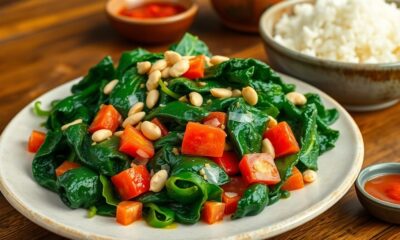Graduations/Birthdays
Baked Ziti
Nestled in the heart of Italian-American cuisine, baked ziti’s rich tomato sauce, creamy cheeses, and tender pasta create a comforting casserole that will leave you craving more.
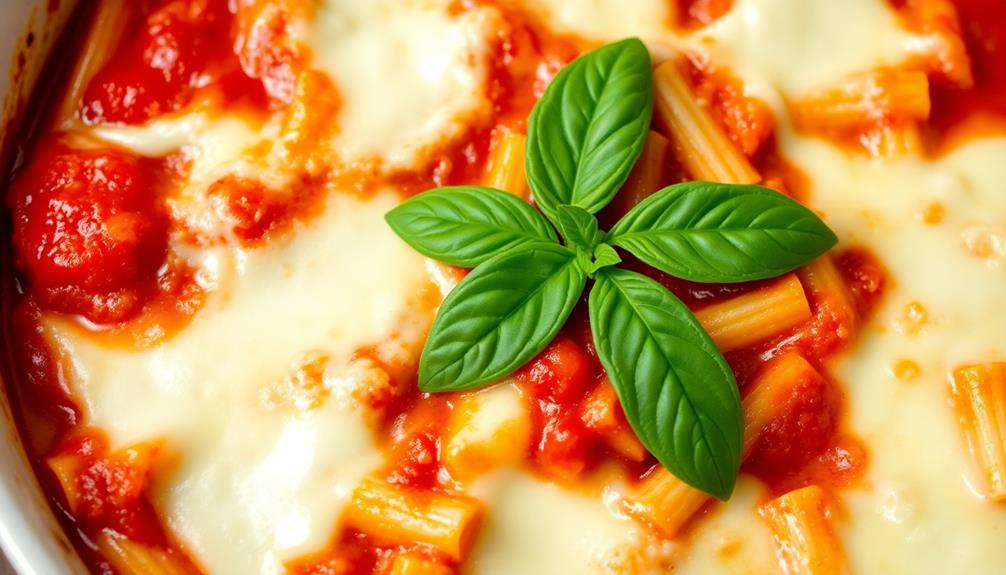
Baked ziti hails from the sun-drenched regions of Southern Italy, blending rich tomato sauce, creamy cheeses, and tender pasta into a comforting casserole. Italian immigrants brought this beloved dish to the U.S., where it's become a staple in households across the country. You'll love layering the ziti, sauce, and cheeses before baking it to golden, bubbly perfection. It's the perfect meal for gathering with family and friends, offering a taste of tradition that'll have you coming back for more. And if you keep reading, you'll discover even more about this classic Italian-American comfort food.
Key Takeaways
- Baked ziti is a classic Italian-American casserole dish that combines pasta, a rich tomato-based sauce, and creamy cheese fillings.
- Baked ziti has its origins in the Campania region of Southern Italy and was adapted by Italian immigrants in the United States.
- The dish is a family favorite, often associated with special occasions and celebrations, and is known for its comforting and satisfying flavors.
- Preparation involves layering cooked pasta, cheese, and sauce before baking until golden and bubbly, resulting in a visually appealing and delicious meal.
- Baked ziti is versatile and can be customized to accommodate dietary preferences, making it a balanced and nutritious option when served with a fresh salad and bread.
History
Baked ziti, a beloved pasta dish, can be traced back to the rich culinary traditions of Southern Italy. This classic comfort food has its roots in the Campania region, where it was initially prepared using a mixture of pasta, tomato sauce, and ricotta cheese. The dish's name, "ziti," refers to the long, tubular pasta that's typically used.
Over time, baked ziti evolved as Italian immigrants brought the recipe to the United States, incorporating local ingredients and personal touches. The dish became a staple in Italian-American households, where it was often served on special occasions or as a crowd-pleasing main course.
Today, baked ziti remains a beloved classic, enjoyed for its warm, cheesy goodness and the comfort it brings. Whether it's a family gathering or a simple weeknight meal, this timeless dish continues to delight taste buds across generations.
Recipe
Baked ziti is a classic Italian-American casserole dish that combines a rich, tomato-based sauce with tender pasta and a creamy cheese filling. This hearty and comforting meal is perfect for feeding a crowd or enjoying as a cozy weeknight dinner.
To make this dish, you'll need to prepare a flavorful tomato sauce, assemble the layers of pasta and cheese, and then bake it all together until the top is golden and bubbly. The result is a satisfying and indulgent dish that's sure to become a family favorite.
Ingredients:
- 1 pound ziti pasta
- 1 pound ground beef or Italian sausage
- 1 onion, diced
- 3 cloves garlic, minced
- 1 (28-ounce) can crushed tomatoes
- 1 (6-ounce) can tomato paste
- 1 teaspoon dried oregano
- 1 teaspoon dried basil
- 1/2 teaspoon salt
- 1/4 teaspoon black pepper
- 15 ounces ricotta cheese
- 2 cups shredded mozzarella cheese
- 1/2 cup grated Parmesan cheese
Instructions:
Preheat your oven to 375°F (190°C). Cook the ziti according to the package instructions until al dente, then drain and set aside.
In a large skillet, cook the ground beef or sausage over medium-high heat until browned and crumbled. Add the onion and garlic, and sauté until the onion is translucent. Stir in the crushed tomatoes, tomato paste, oregano, basil, salt, and pepper. Simmer the sauce for 10-15 minutes, stirring occasionally, to allow the flavors to meld.
In a large mixing bowl, combine the cooked ziti, ricotta cheese, and 1 cup of the mozzarella cheese. Spread half of the ziti mixture into a 9×13-inch baking dish. Top with half of the tomato sauce, then sprinkle with half of the remaining mozzarella and Parmesan cheeses.
Repeat the layers once more, ending with the cheese. Bake the baked ziti for 25-30 minutes, or until the cheese is melted and the top is golden brown. Allow the dish to cool for 5-10 minutes before serving. Enjoy your delicious homemade baked ziti!
Cooking Steps
Preheat your oven to 375°F and get ready to cook up some delicious baked ziti!
First, you'll need to cook the ziti pasta according to the package instructions.
Then, mix the cheese, sauce, and cooked pasta in a bowl.
Step 1. Preheat Oven to 375°F
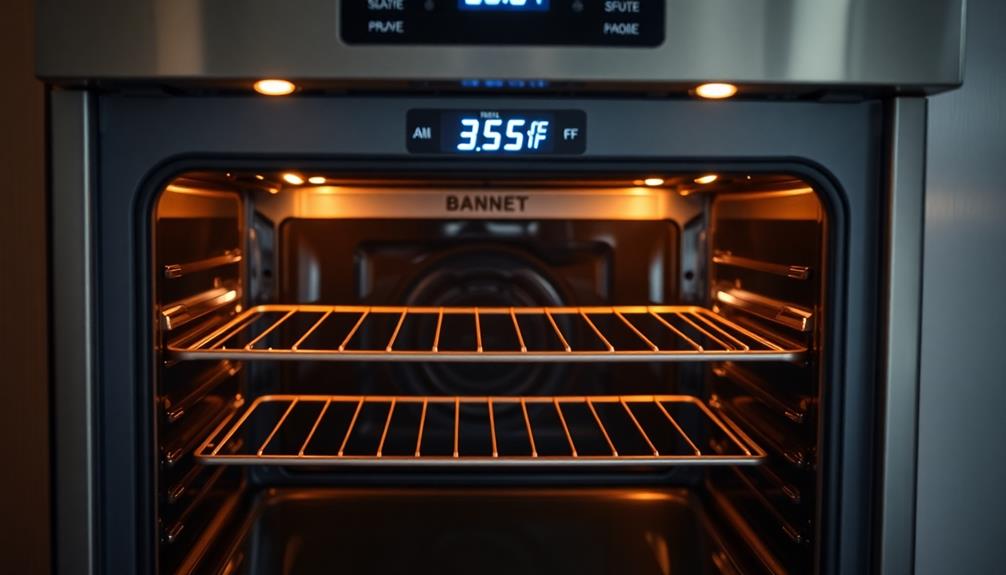
Before you begin assembling the ziti, it's important to preheat your oven to 375°F. This ensures your oven is at the perfect temperature when you're ready to bake. Preheating is a crucial step that helps the ziti cook evenly and develop a delicious, golden-brown crust on top.
To preheat your oven, locate the temperature dial or digital display and turn it to 375°F. It's a good idea to use an oven thermometer to double-check the temperature, as some ovens can be slightly off.
Once the oven is preheated, you'll know it's ready when the indicator light turns off or the display shows the target temperature has been reached.
Now that your oven is nice and hot, you can start assembling the ziti. By taking this important first step, you're well on your way to creating a bubbly, cheesy baked ziti that's sure to be a hit with your family and friends.
Step 2. Cook Ziti Pasta per Package
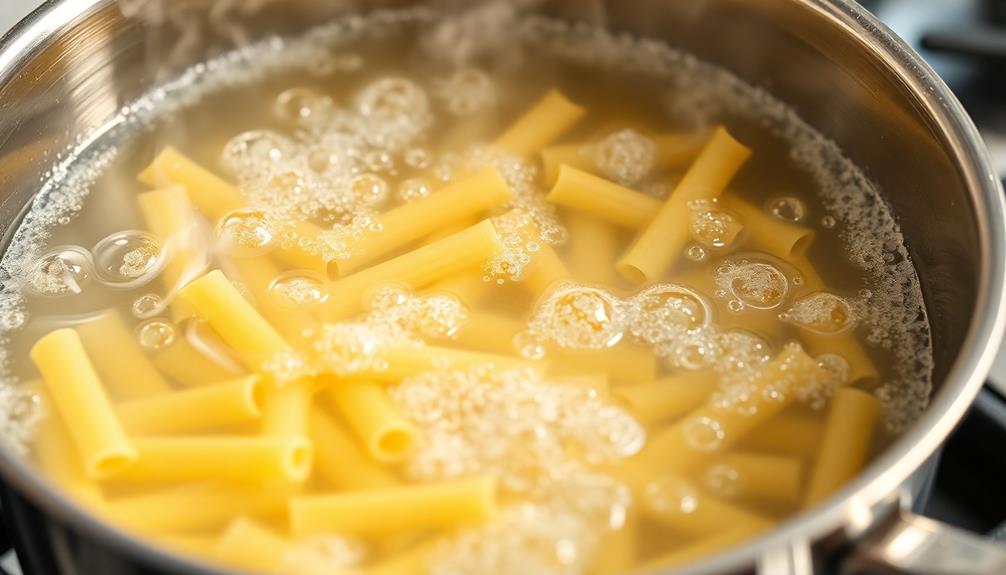
To cook the ziti pasta, follow the instructions on the package. Typically, you'll need to bring a large pot of salted water to a boil.
Once the water is boiling, carefully add the ziti and stir gently. Cook the pasta according to the package directions, usually around 8-12 minutes, until it's al dente – tender, but still firm to the bite. Be sure to stir the pasta occasionally as it cooks to prevent sticking.
When the pasta is done, drain it in a colander, then return it to the pot. Give it a quick rinse with cool water to stop the cooking process. This helps the ziti hold its shape better in the baked dish.
Now you're ready to assemble the baked ziti! Measure out the required amount of pasta and get ready to layer it with the sauce and cheese. The cooked ziti is the foundation for the delicious baked casserole to come.
Step 3. Mix Cheese, Sauce, and Pasta

For the baked ziti, you'll want to combine the cooked ziti, pasta sauce, and shredded mozzarella cheese in a large bowl.
Gently mix the ingredients together until they're evenly distributed. Be careful not to overmix, as you don't want to break up the ziti.
Next, transfer the cheesy ziti mixture to a baking dish. Spread it out evenly, making sure to get it into the corners.
If you'd like, you can sprinkle some extra mozzarella on top for a bubbly, melted topping.
Now it's time to bake your creation! Slide the dish into a preheated oven and let the ziti bake until the cheese is melted and the edges are golden brown.
This should take around 30 minutes. Keep an eye on it to make sure it doesn't overcook.
Once it's done, you'll have a warm, comforting baked ziti dish ready to enjoy.
Serve it up and get ready for rave reviews from your family and friends!
Step 4. Pour Mixture Into Baking Dish

Next, transfer the cheesy ziti mixture to a baking dish.
Grab a 9×13 inch baking dish and give it a light spray with nonstick cooking spray. This will help the ziti slide out easily when it's time to serve.
Carefully pour the ziti mixture into the prepared baking dish, using a spoon to spread it out in an even layer. Make sure the pasta, cheese, and sauce are evenly distributed throughout the dish.
Once it's all in the pan, you're ready for the final step – baking! Preheat your oven to 375°F.
Slide the baking dish onto the middle rack and let the ziti bake for 30-35 minutes, or until the cheese on top is melted and bubbly. The aroma will start to fill your kitchen, making your mouth water in anticipation.
When the timer goes off, use oven mitts to carefully remove the hot dish from the oven. Now you're ready to dig in and enjoy your homemade baked ziti!
Step 5. Bake Until Cheese Is Melted
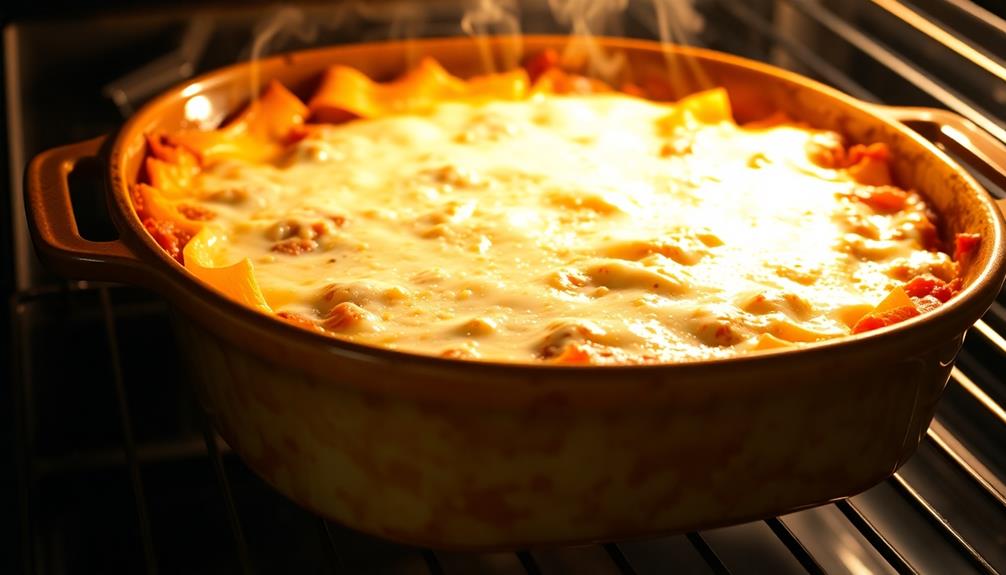
Preheat your oven to 375°F. Once the oven is ready, you'll want to carefully pour the ziti mixture into a 9×13 inch baking dish.
Make sure to spread it out evenly so the baking is nice and consistent. Next, sprinkle the top with the remaining shredded mozzarella cheese. This will create that lovely, melted cheese topping when it's done baking.
Pop the baking dish into the preheated oven and let it bake for 20-25 minutes. Keep an eye on it, as you want the cheese to be fully melted and starting to turn a light golden brown on top.
The baking time may vary slightly depending on your oven, so be sure to check it periodically. Once it's reached that perfect, bubbly, cheesy state, you can remove it from the oven.
Let it cool for a few minutes before serving up those delicious bites of baked ziti. Enjoy!
Final Thoughts
After preparing this delectable baked ziti, you can sit back, relax, and savor the flavors. The ooey-gooey cheese, the tangy marinara sauce, and the hearty noodles come together in a mouthwatering masterpiece.
As you take that first bite, you'll be transported to a cozy Italian kitchen, with the aromas of garlic and herbs swirling around you.
This dish is sure to impress your family and friends. Serve it up with a fresh salad and some crusty garlic bread, and you've got a complete, satisfying meal. For a special touch, consider starting the meal with a classic shrimp cocktail recipe. The combination of chilled cooked shrimp, tangy cocktail sauce, and a squeeze of lemon is always a crowd-pleaser. And don’t forget to pair it with a crisp glass of white wine for the perfect start to a delicious evening. Your guests will be raving about this meal for weeks to come.
Don't be surprised if your guests go back for seconds – or even thirds! The leftovers also make a fantastic lunch the next day, so you can enjoy the flavors all over again.
Whether you're cooking for a crowd or savoring it solo, this baked ziti is a true delight. Enjoy every bite and bask in the joy of a job well done in the kitchen.
Frequently Asked Questions
Can Baked Ziti Be Made Ahead of Time?
Yes, you can make baked ziti ahead of time. Prepare the dish, let it cool, then cover and refrigerate it for up to 3 days. When ready to serve, simply bake it until hot and bubbly.
How Can I Make Baked Ziti Healthier?
You can make baked ziti healthier by using whole wheat pasta, adding extra vegetables, reducing the amount of cheese, and using low-fat or fat-free ricotta and mozzarella. Experiment with different spices and herbs to boost flavor without extra calories.
Can I Freeze Baked Ziti?
You can absolutely freeze baked ziti! Simply assemble the dish, let it cool completely, and then pop it in the freezer. When you're ready to enjoy it, just thaw and reheat in the oven.
How Do I Reheat Leftover Baked Ziti?
To reheat leftover baked ziti, you can place it in an oven-safe dish, cover it with foil, and bake it at 350°F for 20-25 minutes, or until heated through. Alternatively, you can reheat individual portions in the microwave, checking and stirring frequently until warmed.
What's the Best Cheese to Use for Baked Ziti?
When it comes to the best cheese for baked ziti, you can't go wrong with a blend of mozzarella and Parmesan. The mozzarella provides that classic stringy texture, while the Parmesan adds a delightful depth of flavor.
Conclusion
You've gotta try this baked ziti! It's an absolute delight – the perfect combination of pasta, cheese, and rich tomato sauce. Once you've mastered the recipe, you'll be whipping up this comforting dish for all your friends and family. Trust me, they'll be begging you to make it again and again. So what are you waiting for? Preheat that oven and get cooking!
Graduations/Birthdays
Fruit-Infused Water
Alluring and hydrating, fruit-infused water offers a refreshing twist on plain H2O, providing a delightful blend of flavors and health benefits. Discover how to create your own unique concoction.

Fruit-infused water is a delightful and healthy beverage that's captivated health-conscious folks for ages. Ancient Egyptians added citrus slices to their water, while Greeks steeped herbs and flowers for fragrant drinks. Over time, the introduction of new fruits from global trade routes expanded the flavor possibilities. Today, fruit-infused water is loved for its refreshing taste, vibrant colors, and impressive wellness benefits – it promotes hydration, provides vitamins and antioxidants, and even aids digestion. All you need is some fresh fruit, cold water, and a little patience to create your own custom thirst-quenching treat. Keep reading to discover more tasty details!
Key Takeaways
- Fruit-infused water is a beverage made by steeping sliced fresh fruits in water, providing a flavorful and hydrating alternative to plain water.
- The history of fruit-infused water dates back to ancient civilizations, where it was used for refreshment and showcasing wealth.
- Fruit-infused water can be prepared by combining sliced fruits with cold water, refrigerating for 2-24 hours, and serving chilled over ice.
- Fruit-infused water offers a variety of flavor profiles, allowing for creative combinations of citrus, berries, herbs, and tropical fruits.
- Consuming fruit-infused water can promote hydration, provide vitamins and antioxidants, and support weight management by reducing the intake of sugary beverages.
History
The concept of infusing water with fresh fruit dates back centuries, with various cultures around the world incorporating this practice into their culinary traditions.
In ancient Egypt, people would add slices of citrus fruits to their drinking water to make it more refreshing. Similarly, in ancient Greece, they'd steep herbs and flowers in water to create fragrant and flavorful beverages.
Moving forward, the popularity of fruit-infused water grew, particularly in Europe during the Middle Ages. Nobles would often serve these infusions at elaborate feasts, showcasing their wealth and sophistication.
As trade routes expanded, new fruits and flavors were introduced, allowing people to experiment and create unique infusions.
Today, fruit-infused water remains a beloved and versatile drink, enjoyed for its health benefits, refreshing taste, and beautiful presentation.
Whether you're looking to stay hydrated, add a touch of natural sweetness, or simply enjoy a colorful and aromatic beverage, the history of fruit-infused water is sure to inspire your next glass.
Recipe
Fruit-infused water is a refreshing and healthy way to stay hydrated throughout the day. The natural sweetness of the fruit combined with the crisp taste of water creates a delightful flavor profile that can be customized to suit individual preferences.
Preparing fruit-infused water is a simple and straightforward process that allows for endless flavor combinations. Whether you prefer a citrusy blend or a more subtle, floral infusion, the versatility of this beverage makes it a perfect choice for any occasion.
- 1 pitcher or large water bottle (approximately 64 oz)
- 2-3 cups of mixed fruit (e.g., sliced strawberries, lemon or lime wedges, orange slices, cucumber, mint leaves)
- 8 cups of cold water
In a pitcher or large water bottle, combine the desired fruit and water. Gently stir to ensure the fruit is evenly distributed. Refrigerate for at least 2 hours, or up to 24 hours, to allow the flavors to infuse. The longer the water infuses, the more pronounced the fruit flavors will be. Serve chilled and enjoy the refreshing, naturally flavored water.
When making fruit-infused water, it's important to use fresh, ripe fruit for the best flavor. Experiment with different fruit combinations to find your personal favorite. Remember to replenish the water as needed and to enjoy your creation within 2-3 days for maximum freshness.
Cooking Steps
Slice your favorite fruits and add them to a pitcher of water.
Pop it in the fridge for at least 2 hours so the flavors can blend.
Don't forget to give it a stir every so often!
Serve the refreshing fruit-infused water over ice and enjoy the delightful, infused taste.
Step 1. Slice Fruit and Add to Water

Gather your choice of fresh, vibrant fruit and a pitcher or large jar. Decide on the flavors you'd like to create, whether it's a combination of citrus, berries, or tropical fruits.
Grab a cutting board and a sharp knife, and start slicing your fruit into thin, even pieces. Take care to avoid any bruising or damage to the delicate flesh.
As you add the sliced fruit to the water, be mindful of the proportions. A good rule of thumb is to use about 2 cups of fruit per 1 quart of water.
Gently stir the mixture, ensuring the fruit is fully submerged. Cover the pitcher or jar and let it sit in the refrigerator for at least 2 hours, allowing the flavors to infuse the water. The longer it steeps, the more pronounced the flavor will be.
When ready to serve, use a ladle to pour the fruit-infused water into glasses, making sure to include a few slices of fruit in each pour.
Enjoy this refreshing and healthy beverage throughout the day, and feel free to experiment with different fruit combinations to find your perfect blend.
Step 2. Refrigerate for at Least 2 Hours

Once you've added the sliced fruit to the water, it's time to let the flavors infuse. Place the pitcher or container in the refrigerator and let it chill for at least 2 hours. This time is crucial for the fruit's natural sweetness and aroma to permeate the water, creating a refreshing and delightful beverage.
As the water chills, the fruit slowly releases its oils and juices, infusing the water with a vibrant and natural flavor. The longer you let it sit, the more intense the fruit flavor will become. Two hours is the minimum, but you can leave it in the fridge for up to 8 hours or even overnight for a stronger taste.
Be patient and resist the temptation to pour a glass right away. The wait is worth it, as the fruit-infused water will be bursting with flavor and perfectly chilled, ready to quench your thirst and delight your taste buds.
Enjoy the refreshing and healthy treat you've created!
Step 3. Stir Periodically for Flavors to Blend

After letting the fruit-infused water chill in the fridge for at least 2 hours, it's time to give it a gentle stir. This simple step helps the flavors blend together, creating a more harmonious and delightful taste. Grab a spoon and give the pitcher or jar a few slow, easy stirs.
You'll notice the water taking on a deeper, more intense fruit flavor as the ingredients mingle and infuse. Stirring periodically is key to ensuring all the fruit's essences fully infuse into the water. This brings out the best possible flavor.
Don't be afraid to give it a good stir every 30 minutes or so while it's chilling. The more you stir, the more robust the fruit flavors will become. After a couple hours, the water should be beautifully flavored and ready to serve.
Enjoy your refreshing, homemade fruit-infused water!
Step 4. Serve Chilled Over Ice

Once the fruit-infused water has been properly stirred, it's time to serve it chilled over ice.
You'll want to grab some ice cubes and fill up a tall glass or pitcher. Carefully pour the colorful, fragrant water over the ice, letting it chill to the perfect temperature. The ice will help to lock in all those amazing fruit flavors, creating a refreshing and invigorating drink.
Additionally, staying hydrated with delicious beverages like fruit-infused water can enhance your overall wellness, as hydration plays a key role in maintaining cognitive function and mood enhancement, as noted in coffee's health benefits.
Serve the fruit-infused water immediately, while it's nice and cold. You can even add a few extra slices of fruit to the glass for a beautiful presentation.
The chilled water will be incredibly thirst-quenching and perfect for a hot day. Sip slowly and savor the sweet, fruity notes. This easy-to-make beverage is sure to delight your taste buds and keep you hydrated.
Enjoy your delicious, homemade fruit-infused water!
Step 5. Enjoy Refreshing Fruit-Infused Water

Enjoy the refreshing fruit-infused water you've created. Take a sip and savor the burst of fruity flavors. The combination of fresh fruits, herbs, and water creates a delightful and healthy beverage that's perfect for any time of day. There’s no need to reach for sugary sodas or unhealthy juices when you have such refreshing beverage options at your fingertips. Not only is fruit-infused water delicious, but it’s also a great way to stay hydrated and get some extra vitamins and nutrients. Whether you’re relaxing at home or out and about, this flavorful drink is a wonderful choice to quench your thirst and boost your health.
Whether you're relaxing on a warm afternoon or need a pick-me-up, this fruit-infused water is sure to quench your thirst and delight your taste buds.
The vibrant colors and natural sweetness of the fruits make this drink visually appealing and incredibly refreshing. Experiment with different fruit combinations to find your favorite blend.
Try adding a squeeze of citrus, a few sprigs of mint, or even some sliced cucumber for an extra layer of flavor. The possibilities are endless, so have fun and get creative!
Sip slowly and savor each refreshing gulp. The fruit-infused water is a simple yet impressive way to stay hydrated and enjoy the natural flavors of the season.
Enjoy this wholesome and flavorful beverage anytime, anywhere.
Final Thoughts
Fruit-infused water is a refreshing and healthy way to stay hydrated. With its vibrant colors and delightful flavors, it's no wonder why so many people are falling in love with this tasty trend.
Whether you're looking to switch up your daily hydration routine or simply want to enjoy a delightful treat, fruit-infused water is a fantastic option.
As you continue on your journey of exploring the world of fruit-infused water, remember to have fun and get creative.
Try different combinations of fruits, herbs, and even vegetables to find your perfect blend. Don't be afraid to experiment and discover new favorite flavors.
The beauty of this refreshing drink is that the possibilities are endless.
Frequently Asked Questions
How Long Does Fruit-Infused Water Last in the Refrigerator?
The shelf life of fruit-infused water depends on the ingredients. It'll typically last 3-5 days in the fridge, but some fruits may cause it to spoil faster. Be sure to discard it if it smells or looks off.
Can I Use Frozen Fruit for Fruit-Infused Water?
Yes, you can use frozen fruit for your infused water. Frozen fruit can provide similar flavors and benefits as fresh fruit. Just add it directly to your water and let it infuse for best results.
Is Fruit-Infused Water Good for Weight Loss?
Drinking fruit-infused water can support weight loss, as it provides hydration without added sugars or calories found in other beverages. The fruit adds natural sweetness and flavor, making it a healthy alternative to sugary drinks.
What Are the Best Fruits to Use for Infused Water?
The best fruits for infused water are ones that are crisp, lightly sweet, and low in sugar. Citrus fruits like lemon, lime, and orange work well, as do berries and melons. Experiment to find your favorite flavor combinations.
Can I Reuse the Fruit in My Infused Water?
You can reuse the fruit in your infused water, but the flavor will become weaker with each use. To maintain the best flavor, it's generally recommended to replace the fruit after one or two uses.
Conclusion
You'll love sipping on this refreshing fruit-infused water! It's a delightful and healthy way to enjoy the natural flavors of your favorite fruits. Whether you're relaxing on a warm day or looking for a tasty beverage, this recipe is sure to satisfy. Give it a try, and you'll be hooked on this vibrant and invigorating drink!
Graduations/Birthdays
Roasted Chickpeas
Nutritious and delightfully crunchy, roasted chickpeas are a must-try snack that’ll leave you craving more. Discover the endless possibilities of this versatile ingredient.
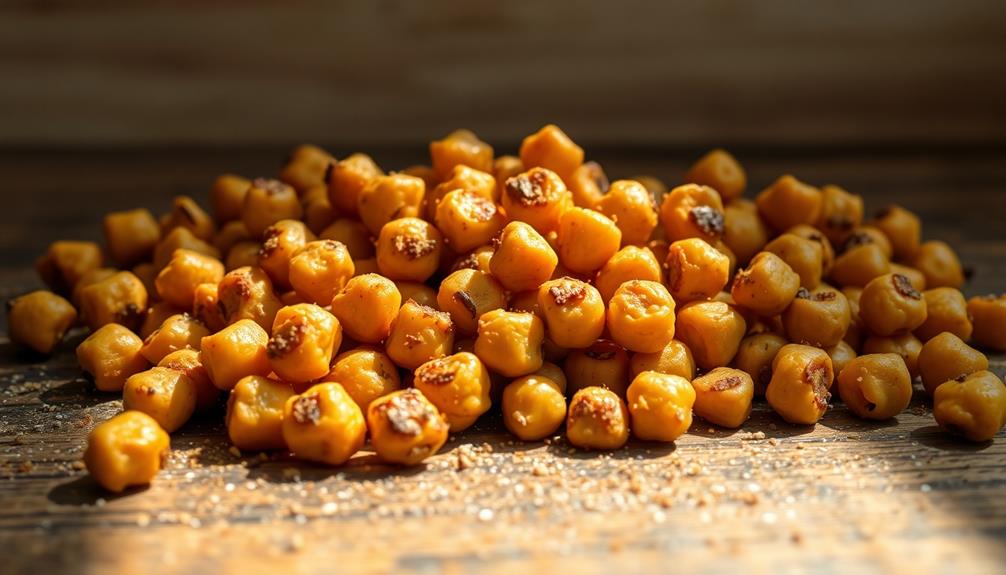
Roasted chickpeas are a must-try snack that'll have your taste buds dancing! Did you know these delightful little legumes have been around for over 7,000 years? Originating in the Middle East, they're a staple in cuisines worldwide. Packed with protein and fiber, they make a nutritious alternative to typical salty snacks. Simply toss chickpeas in olive oil and your favorite spices, then roast until perfectly crispy. The possibilities are endless – try sweet and spicy variations or use them to add crunch to salads and soups. Once you try homemade roasted chickpeas, you'll be hooked! And there's more to discover about this versatile ingredient…
Key Takeaways
- Roasted chickpeas are a high-protein, low-calorie snack that can be prepared by tossing chickpeas in oil and seasonings, then baking until crisp.
- Chickpeas are a nutrient-dense ingredient, providing fiber, protein, and essential vitamins and minerals, making them a healthy snacking option.
- The roasting process enhances the natural nutty flavor of chickpeas and creates a satisfying crunchy texture, making them a versatile ingredient.
- Roasted chickpeas can be customized with various spice blends and flavor profiles, from savory to sweet, to suit personal taste preferences.
- Roasted chickpeas can be enjoyed as a standalone snack, or incorporated into salads, soups, and grain bowls for added texture and nutrition.
History
Chickpeas, also known as garbanzo beans, have been a staple in Middle Eastern and Mediterranean cuisines for over 7,000 years. These nutritious legumes were first cultivated in the Middle East, with evidence of their use found in ancient Egyptian and Mesopotamian settlements.
Over time, they spread throughout the region, becoming a beloved ingredient in traditional dishes like hummus, falafel, and curries.
Roasting chickpeas is a simple and delicious way to enjoy their nutty flavor and crunchy texture. This preparation method has been practiced for centuries, with variations emerging across different cultures.
In the Middle East, roasted chickpeas are often seasoned with spices like cumin, paprika, or coriander, while in the Mediterranean, they may be flavored with herbs like rosemary or thyme.
The popularity of roasted chickpeas has continued to grow, as people around the world discover the joy of this versatile and healthy snack.
Whether enjoyed on their own or incorporated into salads, soups, or other dishes, roasted chickpeas offer a satisfying and nutritious culinary experience.
Recipe
Roasted chickpeas make for a delightful and nutritious snack or addition to salads and bowls. With a simple preparation, you can enjoy the satisfying crunch and bold flavors of this versatile legume. The process of roasting chickpeas brings out their natural nuttiness and unlocks a range of culinary possibilities. Incorporating chickpeas into your diet can also provide a great source of protein and fiber, making them an excellent choice for a low carb high protein breakfast option.
Roasting chickpeas is an easy and straightforward task that can be tailored to suit your taste preferences. Whether you prefer a touch of spice, a hint of herbs, or a classic seasoning blend, the following recipe provides a solid foundation to explore the world of roasted chickpeas.
- 1 (15-ounce) can chickpeas, drained and rinsed
- 1 tablespoon olive oil
- 1 teaspoon ground cumin
- 1/2 teaspoon paprika
- 1/4 teaspoon garlic powder
- 1/4 teaspoon salt
- 1/8 teaspoon black pepper
Preheat your oven to 400°F (200°C). Drain and rinse the chickpeas, then pat them dry with a paper towel or clean kitchen towel. In a mixing bowl, toss the chickpeas with the olive oil, cumin, paprika, garlic powder, salt, and black pepper until evenly coated.
Spread the seasoned chickpeas in a single layer on a baking sheet lined with parchment paper. Roast for 20-25 minutes, stirring halfway, until the chickpeas are golden brown and crispy.
Once the roasted chickpeas have cooled slightly, you can enjoy them as a snack or incorporate them into your favorite dishes. The crunchy texture and bold flavors make them a versatile ingredient that can elevate a simple salad, add a satisfying crunch to grain bowls, or even be enjoyed on their own as a guilt-free treat.
Experiment with different spice blends and seasonings to find your perfect roasted chickpea flavor profile.
Cooking Steps
First, you'll need to drain the chickpeas and pat them dry with a paper towel.
Next, toss the chickpeas with a bit of oil and your favorite seasonings.
Then, spread the seasoned chickpeas out evenly on a baking sheet.
Bake them at 400°F for 20 minutes, flip them, and bake for an additional 10 minutes.
Get ready for deliciously crispy roasted chickpeas!
Step 1. Drain and Pat Chickpeas Dry
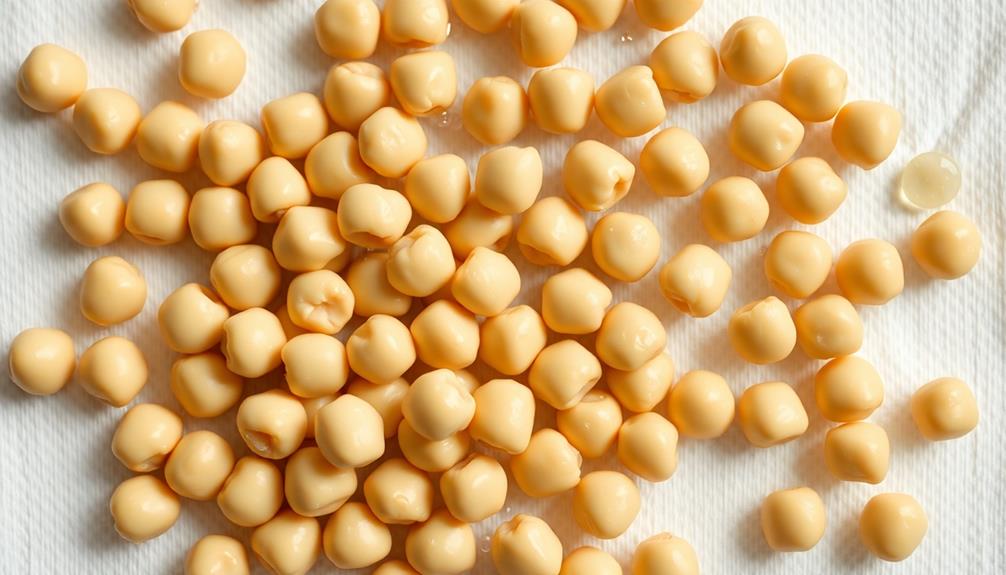
After opening the can, drain the chickpeas in a colander. Make sure to let any excess liquid drip off.
Next, grab a clean paper towel or cloth and gently pat the chickpeas dry. You want to remove as much moisture as possible. This step is crucial for ensuring your chickpeas get nice and crispy when you roast them.
Once the chickpeas are dry, transfer them to a baking sheet. Spread them out in a single layer so they've plenty of room to roast evenly. Resist the urge to overcrowd the pan – you want hot air to circulate around each chickpea.
Now they're ready for the next step: tossing them in oil and seasonings! This will bring out their delicious nutty flavor.
Get excited, because roasted chickpeas make a fantastic crunchy snack or tasty topping for salads and soups. With just a little prep work, you're on your way to enjoying these crispy, flavorful bites. Once you’ve mastered the art of making roasted chickpeas, you can also try your hand at making tasty roasted vegetables to go alongside them. The combination of these crispy chickpeas with savory, flavorful vegetables makes for a satisfying and healthy meal option. Whether you’re looking for a quick snack or a satisfying side dish, roasted chickpeas and vegetables are sure to hit the spot.
Step 2. Toss With Oil and Seasonings

With the chickpeas now dried, it's time to toss them with oil and seasonings. You'll want to add just enough oil to lightly coat the chickpeas, usually around 1-2 tablespoons.
Then, sprinkle on your favorite spices and herbs. Try a mix of garlic powder, paprika, cumin, and a pinch of salt and pepper. The key is to use spices you love to create a flavor profile you enjoy.
Once the oil and seasonings are added, use your hands or a spoon to toss the chickpeas until they're evenly coated. Make sure each chickpea gets a little bit of the delicious seasoning mixture.
This step is important because it's what'll give your roasted chickpeas that amazing flavor. Take your time and thoroughly mix everything together.
With the chickpeas now seasoned and ready, it's time to pop them in the oven and let the roasting begin!
Step 3. Spread Evenly on Baking Sheet
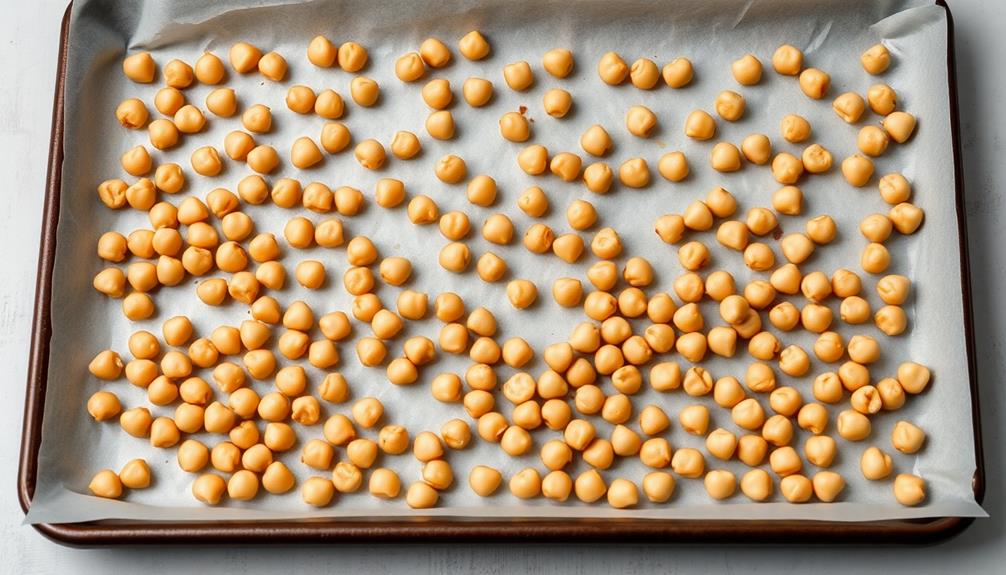
To begin the cooking steps, spread the seasoned chickpeas out in a single layer on a large baking sheet.
You'll want to make sure the chickpeas are spaced apart, not piled on top of each other. This will help them roast evenly and get nice and crispy.
Next, pop the baking sheet into your preheated oven. Roast the chickpeas for 15-20 minutes, giving the pan a gentle shake halfway through.
Keep an eye on them, as you don't want the chickpeas to burn. They're ready when they're golden brown and slightly shrunken in size.
Once they're perfectly roasted, carefully remove the baking sheet from the oven.
Allow the chickpeas to cool for a few minutes before giving them a taste. You'll be amazed at how flavorful and crunchy they are!
Now, you can enjoy your homemade roasted chickpeas as a tasty, healthy snack. They're great on their own or tossed into salads and other dishes.
Step 4. Bake at 400°F for 20 Minutes

Next, preheat your oven to 400°F. Once your oven is ready, it's time to bake those delicious chickpeas! Carefully spread the chickpeas out in a single layer on the prepared baking sheet. This will ensure they cook evenly.
Now, pop the sheet into the preheated oven. Set a timer for 20 minutes and let the chickpeas work their magic. The high heat will transform the chickpeas, making them crispy and golden brown.
As they bake, the aroma will fill your kitchen, teasing your senses. Keep an eye on the chickpeas towards the end of the baking time. You want them to be crispy, but not burnt.
Once the timer goes off, use oven mitts to remove the baking sheet from the oven. Allow the chickpeas to cool slightly before enjoying their delightful crunch.
These roasted chickpeas make a fantastic snack or addition to salads and other dishes. Get ready for a tasty treat!
Step 5. Flip Chickpeas and Bake Additional 10 Minutes
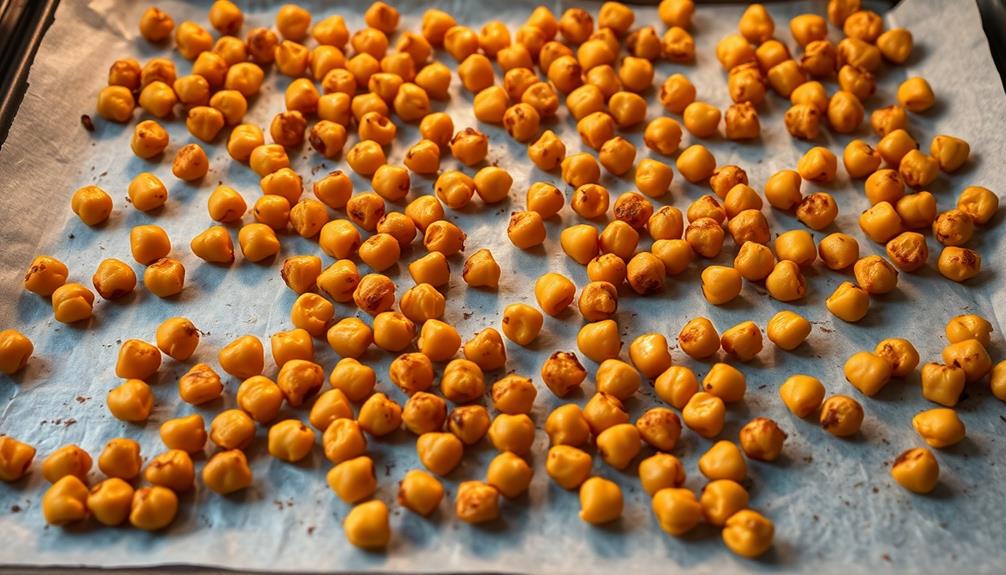
After the first 20 minutes, carefully remove the baking sheet from the oven. The chickpeas should be starting to turn golden brown.
Now, it's time to flip them over to ensure they cook evenly. Using a spatula, gently turn each chickpea so the uncooked side is facing up. Take care not to let any chickpeas fall off the baking sheet.
Once all the chickpeas are flipped, slide the baking sheet back into the oven. Set the timer for an additional 10 minutes. During this time, the chickpeas will continue to roast and develop a delicious, crispy texture.
Keep a close eye on them to prevent burning. The chickpeas are ready when they're golden brown all over and slightly shrunken in size.
Remove the baking sheet from the oven and let the chickpeas cool for a few minutes before serving.
Now, you have a tasty, crunchy snack to enjoy! The flipping and additional baking time ensures your roasted chickpeas are perfectly cooked.
Final Thoughts
Roasted chickpeas make for a fantastic snack or addition to meals. They're crunchy, flavorful, and oh-so-satisfying!
Now that you've mastered the art of roasting these little legumes to perfection, you can experiment with all sorts of seasonings and spices. Try a sprinkle of smoked paprika for a savory kick, or a dash of cinnamon and a pinch of sugar for a sweet and spicy twist. You can even mix things up by tossing the roasted chickpeas into salads, soups, or grain bowls for added texture and nutrition. The possibilities are endless!
The best part is that roasted chickpeas are super easy to make and incredibly versatile. Whether you're looking for a healthy snack to fuel your day or a tasty topping to elevate your meals, these little gems are sure to become a staple in your kitchen.
Frequently Asked Questions
How Long Do Roasted Chickpeas Last?
You can enjoy the roasted chickpeas for up to a week when stored properly in an airtight container at room temperature. Their shelf-life may vary depending on the ingredients and storage conditions, so it's best to keep an eye on their freshness.
Can I Use Canned Chickpeas for This Recipe?
Yes, you can use canned chickpeas for this recipe. Canned chickpeas are already cooked, so you don't need to soak or boil them before roasting. Just drain and pat them dry before tossing with oil and seasonings.
Are Roasted Chickpeas Good for Weight Loss?
Roasted chickpeas can be a great snack for weight loss. They're high in protein and fiber, which can help keep you feeling full. Just be mindful of portion sizes, as they're still a source of calories.
Can I Make Roasted Chickpeas in an Air Fryer?
You can definitely make roasted chickpeas in an air fryer. The air fryer's high heat and circulating air will give the chickpeas a crispy texture without the need for excess oil. It's a healthy and convenient way to enjoy this snack.
How Can I Make Roasted Chickpeas More Flavorful?
To make your roasted chickpeas more flavorful, try adding spices like cumin, garlic powder, or paprika. You can also toss them in a bit of olive oil and seasonings before air frying for extra flavor.
Conclusion
Roasted chickpeas are a delightful, crunchy snack that'll have you coming back for more! They're a cinch to make, and you can customize the flavors to your taste. Pop 'em in your mouth, and let the satisfying crunch and savory spices transport you to snack heaven. Trust us, once you start, you won't be able to stop. So, what are you waiting for? Get roasting and enjoy the deliciousness!
Graduations/Birthdays
Cucumber Sandwiches
Timeless and sophisticated, cucumber sandwiches have graced the tables of the British elite for generations, offering a delightful and refreshing culinary experience. Discover their rich history and how to perfect this classic treat.
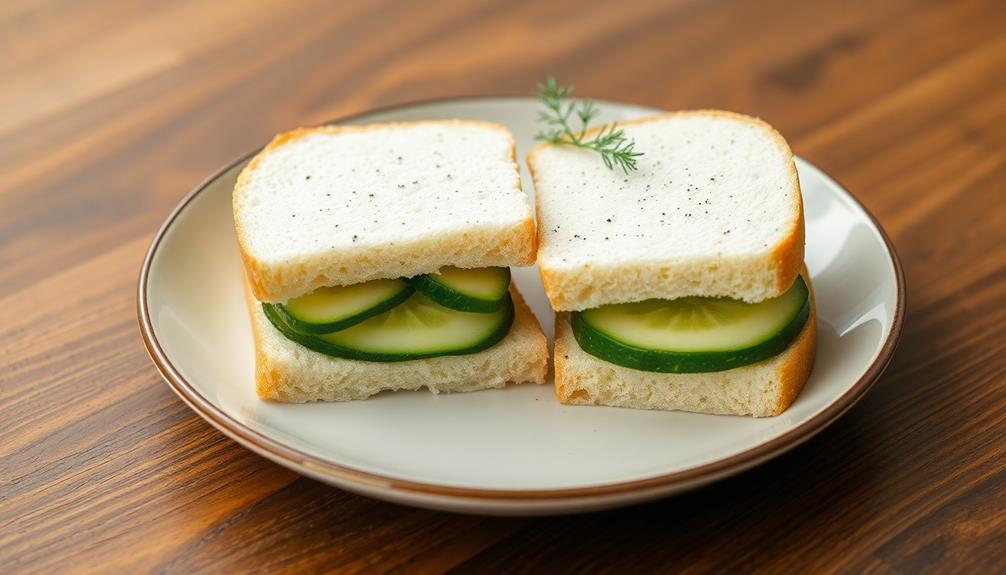
You'll love the rich history behind cucumber sandwiches! These dainty treats have been beloved by the British upper class for centuries, symbolizing refined sophistication at afternoon teas and garden parties. To make them, you'll need fresh white bread, crisp cucumber slices, and a creamy spread. Layer the ingredients neatly, then cut the sandwiches into quarters for an elegant presentation. Chilling them before serving enhances their refreshing flavor. Cucumber sandwiches make a delightful and healthy snack, perfect for any gathering. Keep reading to discover more about their cultural significance and how to prepare them perfectly.
Key Takeaways
- Cucumber sandwiches have origins in British aristocratic culture and were popularized in the 19th century as a symbol of refinement and leisure.
- Cucumber sandwiches are a staple in British afternoon tea traditions, often associated with social events and gatherings.
- The recipe includes fresh white bread, thinly sliced cucumbers, and optional ingredients like cream cheese, herbs, and seasonings.
- Proper preparation involves evenly spreading cream cheese on the bread, neatly layering cucumber slices, and cutting the sandwiches into quarters or triangles.
- Cucumber sandwiches offer a light and refreshing option, providing nutritional benefits from the low-calorie cucumber and potential whole grain bread.
History
Although the precise origins of cucumber sandwiches remain uncertain, they've long been associated with British aristocratic culture.
These delicate finger sandwiches were once a staple at high tea and garden parties, enjoyed by the upper class as a refreshing treat. The cool, crisp cucumber perfectly complemented the soft, pillowy bread, creating a delightful contrast in both texture and flavor.
Cucumber sandwiches gained popularity in the 19th century, when the upper echelons of society embraced this simple yet elegant dish. It became a symbol of refinement and leisure, a way for the privileged to showcase their discerning tastes.
As the trend spread, these sandwiches became a hallmark of polite socializing, gracing the tables of grand country estates and elegant drawing rooms.
Today, cucumber sandwiches continue to evoke a sense of timeless sophistication, reminding us of a bygone era of gentility and proper etiquette.
While their origins may remain a mystery, their enduring appeal is undeniable.
Recipe
Cucumber sandwiches are a classic British tea-time treat. These delicate, refreshing sandwiches are perfect for a summer garden party or an afternoon of relaxation. The key to making the perfect cucumber sandwich lies in the selection and preparation of the ingredients.
First and foremost, choose the freshest and crispest cucumbers you can find. Avoid watery or overly mature cucumbers, as they can make the sandwiches soggy. Additionally, it's important to slice the cucumbers thinly and evenly to ensure a delicate texture.
- 8 slices of fresh white bread
- 1 large cucumber, peeled and thinly sliced
- 2 tablespoons unsalted butter, softened
- 2 tablespoons cream cheese, softened
- 1 tablespoon chopped fresh dill (optional)
- Salt and white pepper to taste
To assemble the sandwiches, lightly butter the bread slices. Spread a thin layer of cream cheese on half of the slices, and arrange the cucumber slices on top. Sprinkle with a pinch of salt, white pepper, and fresh dill (if using). Top with the remaining bread slices to create the sandwiches.
When serving, it's essential to remove the crusts from the sandwiches for a delicate, traditional presentation. Additionally, consider cutting the sandwiches into quarters or triangles to make them bite-sized and easy to enjoy. To add even more elegance to the presentation, garnish the sandwiches with a sprinkle of paprika or fresh dill. For an extra special touch, consider using a delicious egg salad recipe that includes a hint of dijon mustard and finely chopped chives for a burst of flavor. This attention to detail will not only impress your guests but also enhance their overall dining experience.
Serve the cucumber sandwiches chilled and accompany them with a refreshing beverage, such as iced tea or lemonade, for a perfect afternoon delight.
Cooking Steps
First, you'll need to thinly slice the cucumber using a sharp knife or a mandoline slicer.
Next, spread the bread with a generous layer of creamy, tangy cream cheese.
Then, neatly arrange the cucumber slices on top of the cream cheese, and finish it off with a sprinkle of your favorite seasoning.
Step 1. Thinly Slice the Cucumber
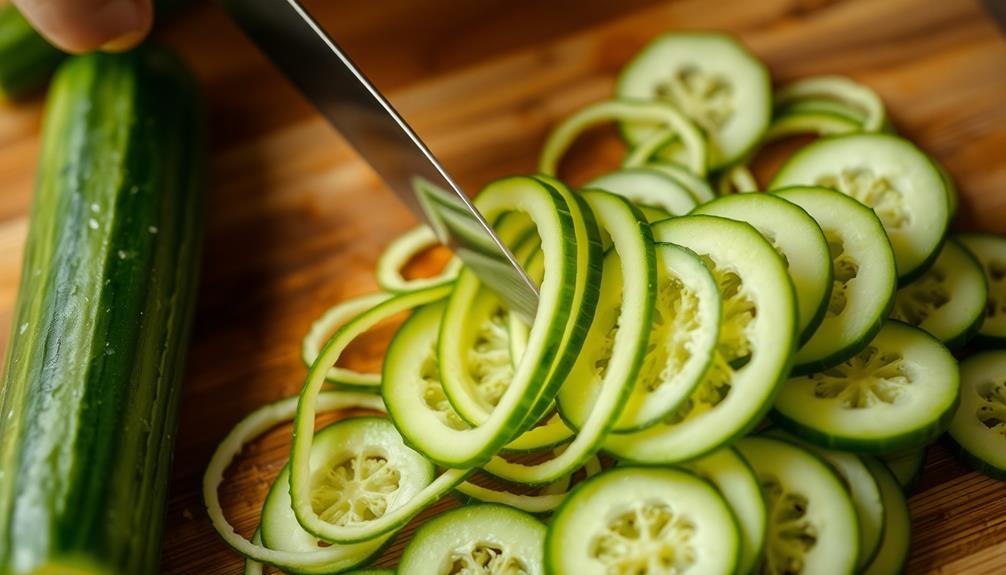
To thinly slice the cucumber, you'll want to use a sharp knife or a mandoline slicer. This is an important step, as you'll want the cucumber slices to be thin and even, so they'll fit nicely on your sandwich.
Start by rinsing the cucumber under cool water and patting it dry with a paper towel. Then, place it on a cutting board and hold it steady with one hand.
Using your other hand, carefully slide the knife or mandoline slicer down the length of the cucumber, creating thin, uniform slices. Try to keep the slices around 1/8 inch thick, as this will give you the perfect texture for your cucumber sandwiches.
Be sure to work slowly and safely, keeping your fingers tucked back to avoid any accidental cuts. With a little practice, you'll be slicing cucumbers like a pro in no time!
Step 2. Spread Bread With Cream Cheese
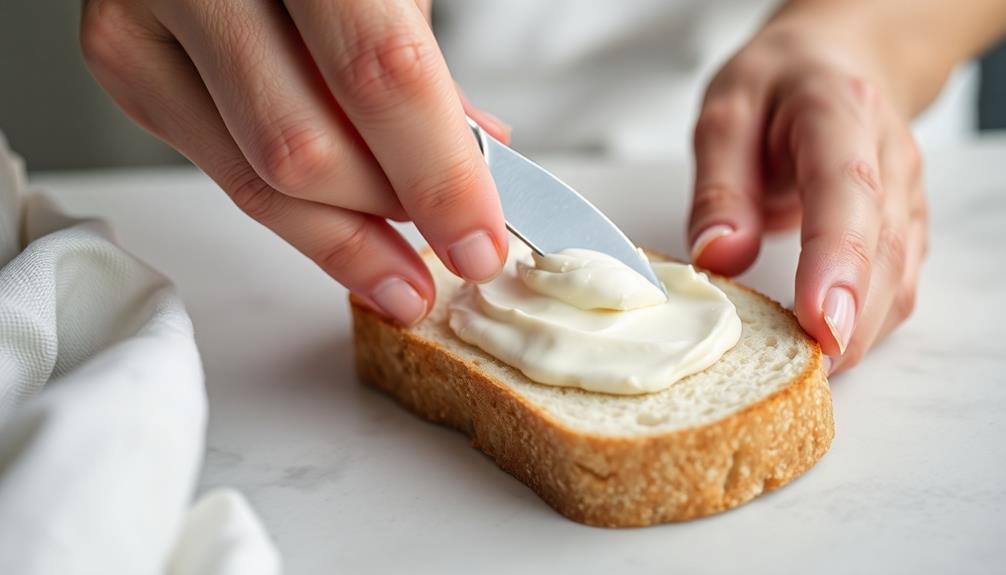
Next, spread a layer of cream cheese onto the slices of bread. Use a butter knife to evenly coat each slice, from corner to corner.
The cool, creamy texture of the cheese will provide a perfect contrast to the crisp, fresh cucumber slices. Be generous with the amount of cream cheese, as it'll help hold the sandwich together and add a delightful creaminess in every bite.
Take care to spread the cream cheese all the way to the edges of the bread. This ensures the cucumber slices will be fully supported and won't slide around.
Plus, it creates a neat, professional-looking sandwich. Once both slices are coated, you're ready to start assembling your cucumber sandwiches.
The cream cheese acts as the "glue" to hold everything in place, so the cucumbers stay put between the bread.
Step 3. Layer Cucumber Slices
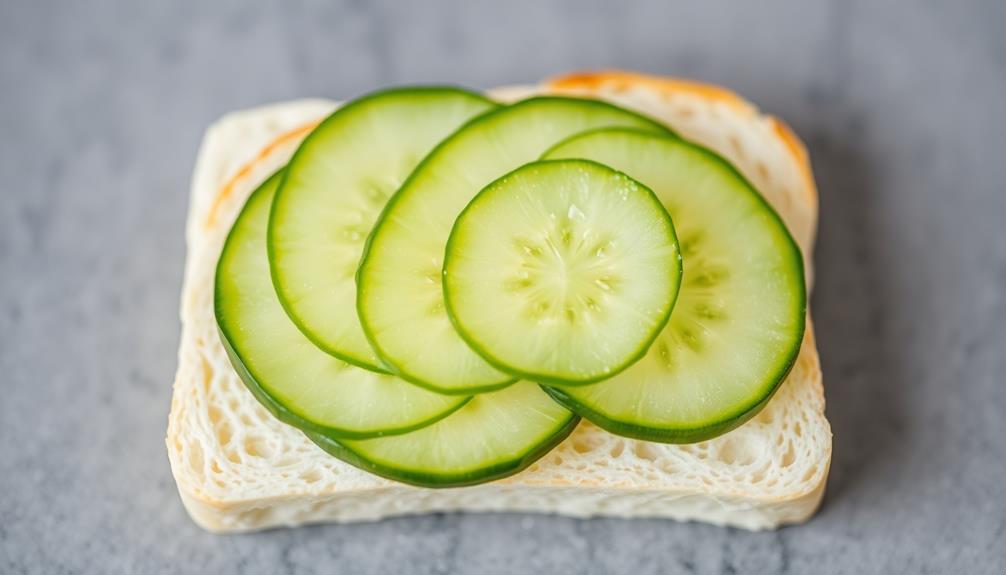
With the cream cheese spread evenly across the bread, it's time to start assembling the cucumber sandwiches.
Grab the fresh cucumber and slice it into thin, even pieces. Make sure the slices aren't too thick, as you want them to layer nicely on the bread.
Arrange the cucumber slices in a single layer, overlapping slightly, covering the entire surface of the cream cheese. Be careful not to let the slices hang over the edges, as you want a neat, tidy presentation.
Once the cucumber is layered, gently press down on the slices to help them adhere to the cream cheese. This will prevent the slices from sliding around when you take a bite.
If you have any gaps or spaces, simply add a few more slices to fill them in.
Step 4. Top With Seasoning
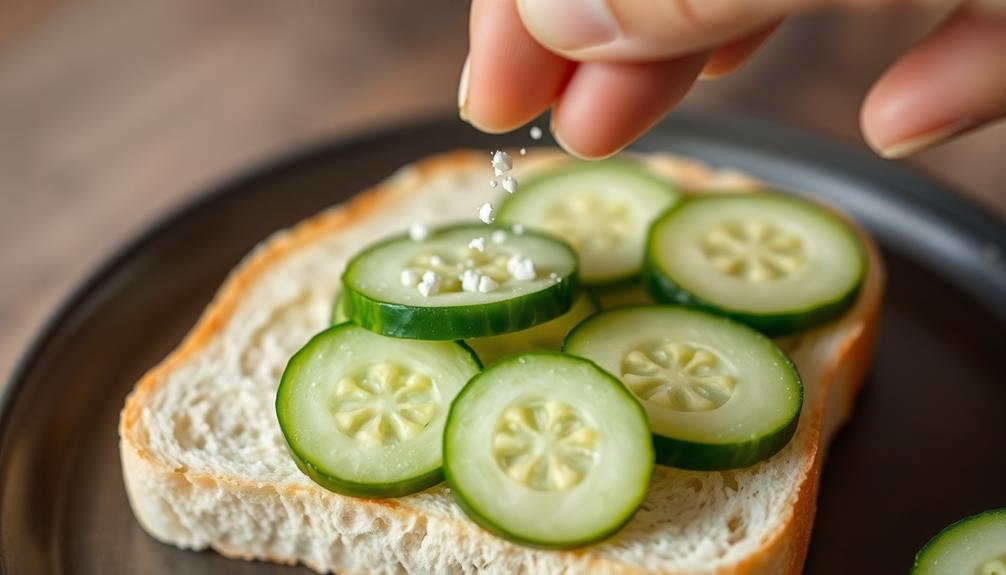
Seasoning the cucumber slices is the final touch that elevates these delightful sandwiches. Start by sprinkling a light layer of salt and pepper over the slices. The salt brings out the natural flavors of the cucumber, while the pepper adds a subtle kick.
If you prefer a little extra zing, try a sprinkle of dried dill or a squeeze of fresh lemon juice.
Next, consider adding a pinch of garlic powder or onion powder for an extra layer of flavor. These seasonings complement the cool, refreshing cucumber perfectly.
Be careful not to overdo it, though – you want the cucumber to shine, not be overpowered.
Once you've seasoned the slices to your liking, give them a gentle pat to help the seasonings adhere.
Now they're ready to be assembled into your delectable cucumber sandwiches! The combination of cool, crisp cucumber and flavorful seasonings is sure to delight your taste buds.
Step 5. Cut Diagonally in Half
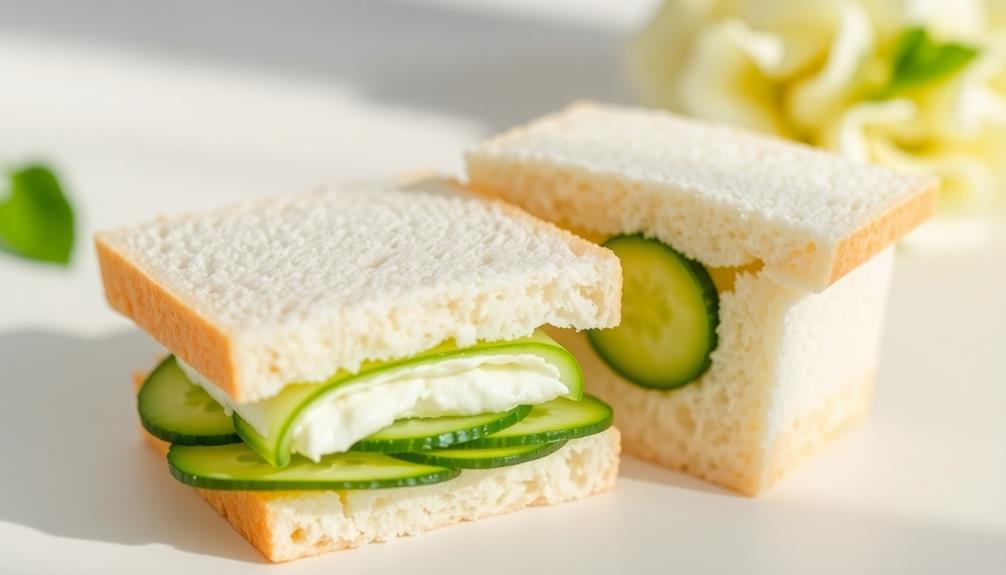
After seasoning the cucumber slices, it's time to cut them diagonally in half. This simple step will create a lovely presentation for your cucumber sandwiches.
Grab a sharp knife and gently place a cucumber slice on your cutting board. Carefully slide the knife through the center of the slice, angling it slightly to create two triangular halves. Repeat this process with each cucumber slice, working slowly and deliberately to ensure clean, even cuts.
The diagonal halves not only look beautiful, but they also make the cucumber slices easier to handle when assembling your sandwiches. The triangle shape allows the cucumber to nestle perfectly onto the bread, creating a visually appealing and delicious result.
Be sure to cut all the slices in the same direction for a consistent look. With the cucumbers neatly halved, you're one step closer to enjoying your freshly made cucumber sandwiches.
Get ready to impress your guests with this simple yet elegant presentation.
Final Thoughts
Ultimately, cucumber sandwiches are a delightful and refreshing option for any occasion. These crisp, cool bites offer a burst of flavor and a satisfying crunch that's perfect for summer gatherings or light lunches.
Whether you prefer them cut into triangles or pinwheels, the simplicity of the cucumber, paired with a creamy spread, creates a harmonious blend of textures and tastes.
Beyond their taste, cucumber sandwiches are also a versatile choice. They can be easily customized to suit different dietary needs or personal preferences.
Swap out the traditional cream cheese for a vegan or dairy-free alternative, or experiment with various herbs and seasonings to add a unique twist.
Most importantly, cucumber sandwiches bring a sense of joy and relaxation to any eating experience. Their refreshing nature and delicate presentation make them the perfect accompaniment to a leisurely afternoon or a casual get-together with friends.
Indulge in the simple pleasures of this timeless treat and savor the delightful flavors of the cucumber sandwich.
Frequently Asked Questions
What Is the Best Bread to Use for Cucumber Sandwiches?
You'll want a light, soft, and delicate bread for cucumber sandwiches. Avoid dense or hearty breads that could overwhelm the cucumber's flavor. Opt for thinly sliced white, whole wheat, or brioche bread to create the perfect bite-sized snack.
Can I Make Cucumber Sandwiches in Advance?
You can make cucumber sandwiches in advance, but they won't stay crisp for long. To keep them fresh, assemble them just before serving or line the bread with a thin layer of butter or cream cheese to create a barrier.
Do I Need to Peel the Cucumbers?
You don't necessarily need to peel the cucumbers, but it's a matter of personal preference. Some people prefer the texture and flavor of peeled cucumbers, while others enjoy the added crunch and nutrients from leaving the skin on.
How Do I Prevent the Bread From Getting Soggy?
To prevent the bread from getting soggy, you can lightly toast the bread, spread a thin layer of butter or cream cheese on the bread, and assemble the sandwich just before serving.
Can I Add Other Vegetables to Cucumber Sandwiches?
Yes, you can add other vegetables to your sandwiches. Experiment with thinly sliced tomatoes, bell peppers, or radishes for extra crunch and flavor. Just be sure not to overload the bread, or it may become soggy.
Conclusion
Cucumber sandwiches are a timeless classic that'll delight your senses. The cool, crisp veggies and soft, pillowy bread create a harmonious balance of flavors and textures. Whether you're hosting a garden party or simply craving a refreshing snack, these sandwiches are sure to hit the spot. Go on, give 'em a try – you won't be disappointed!
-

 Southern Comfort Food1 month ago
Southern Comfort Food1 month agoCheese Straws
-

 Brazilian Cuisine1 month ago
Brazilian Cuisine1 month agoCaldeirada
-

 Southern Comfort Food1 month ago
Southern Comfort Food1 month agoCreamed Corn
-

 Brazilian Cuisine1 month ago
Brazilian Cuisine1 month agoChicken in Brown Sauce
-

 Brazilian Cuisine1 month ago
Brazilian Cuisine1 month agoTacacá
-

 Southern Comfort Food1 month ago
Southern Comfort Food1 month agoSquash Casserole
-

 Southern Comfort Food1 month ago
Southern Comfort Food1 month agoChocolate Gravy
-

 Polish Comfort Food1 month ago
Polish Comfort Food1 month agoKrupnik (Barley Soup)












